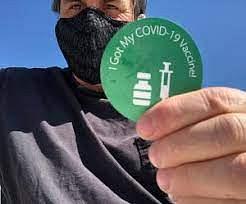Data reveal fewer real-world COVID vaccine side effects
A new real-world study finds fewer side effects after vaccination with the Pfizer/BioNTech and the AstraZeneca/Oxford COVID-19 vaccines than reported in phase 3 clinical trials, while another paper notes some instances of facial paralysis after receipt of the Pfizer or Moderna vaccine but no increased risk.
Mild systemic side effects in 1 of 4
In the first study, King's College London and other UK and US researchers mined data from the 627,383 users of the ZOE COVID Symptom Study app, who self-reported systemic and local side effects within 8 days of the receipt of one or two doses of the Pfizer vaccine or one dose of the AstraZeneca vaccine from Dec 8, 2020, to Mar 10, 2021. The study was published yesterday in The Lancet Infectious Diseases.
After the first Pfizer dose, 13.5% of recipients reported side effects, compared with 22.0% after the second Pfizer dose and 33.7% after the first AstraZeneca dose.
One in four people receiving the Pfizer or AstraZeneca coronavirus vaccines experienced mild systemic side effects. The most common systemic side effect was headache (7.8% of vaccinees after the first Pfizer dose, 13.2% after the second dose, and 22.8% after AstraZeneca).
Other common systemic side effects were muscle aches and fatigue, the latter of which affected 8.4% and 14.4% of Pfizer vaccinees after the first and second doses, respectively, and 21.1% of AstraZeneca vaccinees; these side effects peaked within 24 hours and lasted no more than 2 days.
Among all vaccinees, 66.2% reported at least one side effect at the injection site. Of those receiving the first or second Pfizer doses, 57.2% and 50.9%, respectively, said they had tenderness at the injection site, as did 49.3% after the AstraZeneca vaccine.
In contrast, in phase 3 clinical trials of the Pfizer vaccine, 71% to 83% of vaccinees reported pain at the injection site, 34% to 47% reported fatigue, and 25% to 42% reported headache. Likewise, the AstraZeneca vaccine trials found systemic side effects in 88% of participants 18 to 55 years after the first dose.
Women and those younger than 55 years were most likely to report side effects, and those with a previous COVID-19 diagnosis were three times more likely than others to have systemic side effects after the first Pfizer dose, nearly twice as likely after an AstraZeneca dose, and also more likely to report local side effects.
Mild symptoms, reduced infections
In a King's College London news release, senior study author Tim Spector, MD, said the findings show that most side effects are non-severe and self-limiting. "The data should reassure many people that in the real world, after effects of the vaccine are usually mild and short-lived, especially in the over 50's who are most at risk of the infection," he said.
"Rates of new disease are at a new low in the UK according to the ZOE app, due to a combination of social measures and vaccination, and we need to continue this successful strategy to cover the remaining population."
The study also found a 58% reduction in infections 12 to 21 days after the first dose of the Pfizer vaccine (69% after at least 21 days) and a 39% reduction after the AstraZeneca vaccine (60% after at least 21 days) compared with controls.
"Our data could be used to inform people on the likelihood of side-effects on the basis of their age and sex and the type of vaccine being administered," the authors concluded in the study. "Furthermore, our data support results from randomised controlled trials in a large community-based scenario showing evidence of reduction in infection after 12 days and substantial protection after 3 weeks."
In a commentary in the same journal, Ruth Drury, MD, and Daniel O'Connor, DPhil, both of the University of Oxford, said the differences in side effects between the study and phase 3 trials could be due to differences in study populations, psychological differences in symptom reporting between those receiving an authorized vaccine and clinical trial participants, and study dropout (data may be more complete in clinical trials).
"Overall, this study provides valuable information to health-care professionals and the general public on vaccine reactogenicity and effectiveness in the community setting," they sad. "In this era of rapid dissemination of information, good science communication has a crucial role to play in strengthening public confidence in vaccines and thus maximising vaccine uptake."
No link between vaccine, facial paralysis
In the second study, published yesterday in JAMA Internal Medicine, scientists from Grenoble Alpes University in France used the World Health Organization pharmacovigilance database, VigiBase, to conduct a disproportionality analysis after cases of facial paralysis were reported among participants in the phase 3 clinical trials of the Pfizer and Moderna mRNA vaccines.
The researchers conducted four analyses with two control groups, including all other viral vaccines and then with only flu vaccines, and broad and narrow facial paralysis definitions.
Of the 35,654 participants receiving a vaccine, 7 developed facial paralysis, compared with 1 of 35,611 participants in the placebo group. Although a causal relationship couldn't be established, the US Food and Drug Administration recommended monitoring of vaccine recipients for facial paralysis.
Of the 133,883 adverse reactions to the mRNA COVID-19 vaccines reported by Mar 9, 844 (0.6%) were related to facial paralysis, including 683 cases of facial paralysis, 168 of facial paresis (muscle weakness resulting from temporary or permanent damage to the facial nerve), 25 of facial spasms, and 13 of facial nerve disorders.
Of the 844 total cases, 749 were reported with the Pfizer vaccine and 95 with the Moderna vaccine; 67.8% involved women, and median patient age was 49 years. Median time from vaccination to facial paralysis onset was 2 days (range, 0 to 79).
The researchers identified 5,734 cases of facial paralysis among the 1,265,182 adverse drug reactions reported with other viral vaccines (0.5%) and 2,087 among the 314,980 reported with flu vaccines (0.7%). They didn't observe any disproportionality signal of facial paralysis for broad or narrow facial paralysis definitions compared with other viral or flu vaccines alone.
While isolated cases of facial paralysis have been reported for decades for virtually all vaccines, which are believed to be immune-mediated or produced by viral reactivation (eg, herpes virus), no study has identified a higher risk of vaccination-related facial paralysis, the authors said.
"Despite selective reporting and a potential delay in reporting and transferring cases among pharmacovigilance databases, the reporting rate of facial paralysis after mRNA COVID-19 vaccination found in the present study is not higher than that observed with other viral vaccines," they wrote.
"To conclude, if an association between facial paralysis and mRNA COVID-19 vaccines exists, the risk is likely very low, as with other viral vaccines."





